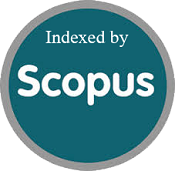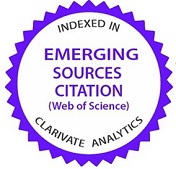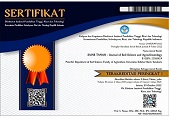Methane (CH₄) emissions exceeding the threshold from chilli cultivation mulching practices in Sleman Regency, Indonesia
Abstract
Methane (CH₄) is a potent greenhouse gas contributing to global warming, although there is limited information on its emissions dynamics in dryland horticulture. Chilli cultivation practices comprising fertilization and mulching may influence CH₄ emissions through alterations in soil temperature and moisture. Therefore, this study aimed to evaluate the effect of different mulching practices on CH₄ emissions and determine the threshold for sustainable chilli cultivation in tropical dryland conditions. A field experiment was conducted in Sleman, Indonesia, using a randomized block design with three mulch treatments. These included unmulched treatment (M0), organic mulch (M1), and plastic mulch (M2), each replicated three times. Gas sampling was performed biweekly for 112 days using the closed chamber method. Soil temperature and Volumetric Water Content (VWC) were recorded using in situ sensors. The results showed that mulch treatments significantly influenced CH₄ emissions (p < 0.001). M1 produced the highest average CH₄ flux (0.114 mg m⁻² h⁻¹), followed by M2 (0.043 mg m⁻² h⁻¹) and M0 (0.016 mg m⁻² h⁻¹). All treatments exceeded the calculated CH₄ threshold of 0.145 mg m⁻² h⁻¹ under certain conditions. These results showed the need for careful mulching selection to reduce environmental impact and support the development of CH₄ emissions threshold for sustainable dryland horticulture.
Keywords
Full Text:
PDFReferences
Akhtar, K., Wang, W., Ren, G., Khan, A., Feng, Y., Yang, G., & Wang, H. (2019). Integrated use of straw mulch with nitrogen fertilizer improves soil functionality and soybean production. Environment International, 132, 105092. https://doi.org/10.1016/j.envint.2019.105092
Alengebawy, A., Mohamed, B. A., Ran, Y., Yang, Y., Pezzuolo, A., Samer, M., & Ai, P. (2022). A comparative environmental life cycle assessment of rice straw-based bioenergy projects in China. Environmental Research, 212, 113404. https://doi.org/10.1016/j.envres.2022.113404
Anshori, A., Sunarminto, B. H., Haryono, E., & Mujiyo, M. (2018). Potential Production of CH4 And N2O in Soil Profiles from Organic and Conventional Rice Fields. Sains Tanah Journal of Soil Science and Agroclimatology, 15(1), 7. https://doi.org/10.15608/stjssa.v15i1.19324
Breivik, Ø., & Aarnes, O. J. (2017). Efficient bootstrap estimates for tail statistics. Nat. Hazards Earth Syst. Sci., 17(3), 357-366. https://doi.org/10.5194/nhess-17-357-2017
Chae, H. G., Song, H. J., Bhuiyan, M. S. I., Kim, P. J., & Lee, J. G. (2022). Unexpected high suppression of ammonia volatilization loss by plastic film mulching in Korean maize cropping system. Agriculture, Ecosystems & Environment, 335, 108022. https://doi.org/10.1016/j.agee.2022.108022
Chaudhary, A., & Sharma, B. K. (2024). An assessment of environmental sustainability of plastic in agriculture. AIP Conference Proceedings, 2802(1). https://doi.org/10.1063/5.0181844
Della Chiesa, T., Piñeiro, G., Del Grosso, S. J., Parton, W. J., Araujo, P. I., & Yahdjian, L. (2022). Higher than expected N2O emissions from soybean crops in the Pampas Region of Argentina: Estimates from DayCent simulations and field measurements. Science of The Total Environment, 835, 155408. https://doi.org/10.1016/j.scitotenv.2022.155408
Feng, S., Leung, A. K., Liu, H. W., Ng, C. W. W., & Tan, W. P. (2020). Modelling microbial growth and biomass accumulation during methane oxidation in unsaturated soil. Canadian Geotechnical Journal, 57(2), 189-204. https://doi.org/10.1139/cgj-2018-0147
Gonzaga, L. C., Zotelli, L. d. C., de Castro, S. G. Q., de Oliveira, B. G., Bordonal, R. d. O., Cantarella, H., & Carvalho, J. L. N. (2019). Implications of Sugarcane Straw Removal for Soil Greenhouse Gas Emissions in São Paulo State, Brazil. BioEnergy Research, 12(4), 843-857. https://doi.org/10.1007/s12155-019-10006-9
Hall, M. K. D., J., W. A., & and Rogers, G. S. (2014). Variations in the Diurnal Flux of Greenhouse Gases from Soil and Optimizing the Sampling Protocol for Closed Static Chambers. Communications in Soil Science and Plant Analysis, 45(22), 2970-2978. https://doi.org/10.1080/00103624.2014.956937
Huang, X., Silvennoinen, H., Kløve, B., Regina, K., Kandel, T. P., Piayda, A., . . . Höglind, M. (2021). Modelling CO2 and CH4 emissions from drained peatlands with grass cultivation by the BASGRA-BGC model. Science of The Total Environment, 765, 144385. https://doi.org/10.1016/j.scitotenv.2020.144385
Jeffrey, L. C. (2019). Wetland methane emissions dominated by plant‐mediated fluxes: contrasting emissions pathways and seasons within a shallow freshwater subtropical wetland. Limnology and Oceanography, 64(5), 1895-1912. https://doi.org/10.1002/lno.11158
Jeong, S. T., Kim, G. W., Hwang, H. Y., Kim, P. J., & Kim, S. Y. (2018). Beneficial effect of compost utilization on reducing greenhouse gas emissions in a rice cultivation system through the overall management chain. Science of The Total Environment, 613-614, 115-122. https://doi.org/10.1016/j.scitotenv.2017.09.001
Karyani, T., Susanto, A., Djuwendah, E., & Hapsari, H. (2020). Red Chili Agribusiness and the Risks Faced by the Farmers. IOP Conference Series: Earth and Environmental Science, 466(1), 012002. https://doi.org/10.1088/1755-1315/466/1/012002
Khazimov, K. M., Niyazbayev, A. K., Shekerbekova, Z. S., Urymbayeva, A. A., Mukanova, G. A., Bazarbayeva, T. A., . . . Khazimov, M. Z. (2021). A novel method and device for plastic mulch retriever. Journal of Water and Land Development(No 49), 85-94. https://doi.org/10.24425/jwld.2021.137100
Kim, G. W., Alam, M. A., Lee, J. J., Kim, G. Y., Kim, P. J., & Khan, M. I. (2017). Assessment of direct carbon dioxide emission factor from urea fertilizer in temperate upland soil during warm and cold cropping season. European Journal of Soil Biology, 83, 76-83. https://doi.org/10.1016/j.ejsobi.2017.10.005
Kim, G. W., Lim, J. Y., Islam Bhuiyan, M. S., Das, S., Khan, M. I., & Kim, P. J. (2022). Investigating the arable land that is the main contributor to global warming between paddy and upland vegetable crops under excessive nitrogen fertilization. Journal of Cleaner Production, 346, 131197. https://doi.org/10.1016/j.jclepro.2022.131197
Kirchman, D. L. (2024). Microbes: The Unseen Agents of Climate Change. Oxford University Press. https://doi.org/10.1093/oso/9780197688564.001.0001
Lage Filho, N. M., Cardoso, A. d. S., Azevedo, J. C. d., Macedo, V. H. M., Domingues, F. N., Faturi, C., . . . do Rêgo, A. C. (2023). How does land use change affect the methane emission of soil in the Eastern Amazon? [Original Research]. Frontiers in Environmental Science, Volume 11 - 2023. https://doi.org/10.3389/fenvs.2023.1244152
Lee, J. g., Chae, H. G., Kim, G. W., Kim, P. J., & Cho, S. R. (2022). Cover cropping and its biomass incorporation: Not enough to compensate the negative impact of plastic film mulching on global warming. Science of The Total Environment, 807, 151015. https://doi.org/10.1016/j.scitotenv.2021.151015
Lee, J. G., Cho, S. R., Jeong, S. T., Hwang, H. Y., & Kim, P. J. (2019). Different response of plastic film mulching on greenhouse gas intensity (GHGI) between chemical and organic fertilization in maize upland soil. Science of The Total Environment, 696, 133827. https://doi.org/10.1016/j.scitotenv.2019.133827
Lee, J. H., Lee, J. G., Jeong, S. T., Gwon, H. S., Kim, P. J., & Kim, G. W. (2020). Straw recycling in rice paddy: Trade-off between greenhouse gas emission and soil carbon stock increase. Soil and Tillage Research, 199, 104598. https://doi.org/10.1016/j.still.2020.104598
Li, C. (2007). Quantifying greenhouse gas emissions from soils: Scientific basis and modeling approach. Soil Science and Plant Nutrition, 53(4), 344-352. https://doi.org/10.1111/j.1747-0765.2007.00133.x
Li, C., Frolking, S., & Frolking, T. A. (1992). A model of nitrous oxide evolution from soil driven by rainfall events: 1. Model structure and sensitivity. Journal of Geophysical Research: Atmospheres, 97(D9), 9759-9776. https://doi.org/10.1029/92JD00509
Li, Y., Xie, H., Ren, Z., Ding, Y., Long, M., Zhang, G., . . . Liao, Y. (2022). Response of soil microbial community parameters to plastic film mulch: A meta-analysis. Geoderma, 418, 115851. https://doi.org/10.1016/j.geoderma.2022.115851
Liu, W., Hussain, S., Wu, L., Qin, Z., Li, X., Lu, J., . . . Geng, M. (2016). Greenhouse gas emissions, soil quality, and crop productivity from a mono-rice cultivation system as influenced by fallow season straw management. Environmental Science and Pollution Research, 23(1), 315-328. https://doi.org/10.1007/s11356-015-5227-7
Liu, Y., Wu, M., Liu, J., Li, D., Liu, X., Chen, L., . . . Liu, M. (2024). Improved Straw Decomposition Products Promote Peanut Growth by Changing Soil Chemical Properties and Microbial Diversity. Sustainability, 16(16), 7096. https://doi.org/10.3390/su16167096
Lubis, F. A., Harisudin, M., & Fajarningsih, R. U. (2019). Strategi pengembangan agribisnis cabai merah di kabupaten Sleman dengan metode Analytical Hierarchy Process [Development Strategy of Red Chili Agribusiness in Sleman Regency using Analytical Hierarchy Process Method]. AGRARIS: Journal of Agribusiness and Rural Development Research, 5(2), 119-128. https://doi.org/10.18196/agr.5281
Mathivanan, G. P., Eysholdt, M., Zinnbauer, M., Rösemann, C., & Fuß, R. (2021). New N2O emission factors for crop residues and fertiliser inputs to agricultural soils in Germany. Agriculture, Ecosystems & Environment, 322, 107640. https://doi.org/10.1016/j.agee.2021.107640
Molina, S., Ruiz, S., Gomez-Soriano, J., & Olcina-Girona, M. (2023). Impact of hydrogen substitution for stable lean operation on spark ignition engines fueled by compressed natural gas. Results in Engineering, 17, 100799. https://doi.org/10.1016/j.rineng.2022.100799
Muhamediyeva, D. T. (2023). Approach to environmental issues. E3S Web of Conf., 402, 09029. https://doi.org/10.1051/e3sconf/202340209029
Munawaroh, U., Komariah, K., Ariyanto, D. P., Zaki, M. K., & Noda, K. (2022). Estimates of methane and nitrous oxide emission from a rice field in Central Java, Indonesia, based on the DeNitrification DeComposition model. Sains Tanah Journal of Soil Science and Agroclimatology, 19(1), 11. https://doi.org/10.20961/stjssa.v19i1.56928
Nayna, O. K., Sarma, V. V. S. S., Begum, M. S., Hartmann, J., Kumar, S., Tareq, S. M., & Park, J.-H. (2022). Reassessing riverine carbon dioxide emissions from the Indian subcontinent. Science of The Total Environment, 816, 151610. https://doi.org/10.1016/j.scitotenv.2021.151610
Ni, X., Liao, S., Wu, F., & Groffman, P. M. (2019). Short-term precipitation pulses stimulate soil CO2 emission but do not alter CH4 and N2O fluxes in a northern hardwood forest. Soil Biology and Biochemistry, 130, 8-11. https://doi.org/10.1016/j.soilbio.2018.11.021
Perez-Coronel, E., & Michael Beman, J. (2022). Multiple sources of aerobic methane production in aquatic ecosystems include bacterial photosynthesis. Nature Communications, 13(1), 6454. https://doi.org/10.1038/s41467-022-34105-y
Rajendran, S., Park, H., Kim, J., Park, S. J., Shin, D., Lee, J.-H., . . . Kim, C. M. (2024). Methane Emission from Rice Fields: Necessity for Molecular Approach for Mitigation. Rice Science, 31(2), 159-178. https://doi.org/10.1016/j.rsci.2023.10.003
Riddick, S. N., Cheptonui, F., Yuan, K., Mbua, M., Day, R., Vaughn, T. L., . . . Zimmerle, D. J. (2022). Estimating Regional Methane Emission Factors from Energy and Agricultural Sector Sources Using a Portable Measurement System: Case Study of the Denver–Julesburg Basin. Sensors, 22(19), 7410. https://doi.org/10.3390/s22197410
Sapkota, T. B., Khanam, F., Mathivanan, G. P., Vetter, S., Hussain, S. G., Pilat, A.-L., . . . Krupnik, T. J. (2021). Quantifying opportunities for greenhouse gas emissions mitigation using big data from smallholder crop and livestock farmers across Bangladesh. Science of The Total Environment, 786, 147344. https://doi.org/10.1016/j.scitotenv.2021.147344
Senapati, N., Chabbi, A., Giostri, A. F., Yeluripati, J. B., & Smith, P. (2016). Modelling nitrous oxide emissions from mown-grass and grain-cropping systems: Testing and sensitivity analysis of DailyDayCent using high frequency measurements. Science of The Total Environment, 572, 955-977. https://doi.org/10.1016/j.scitotenv.2016.07.226
Shaukat, M., Samoy-Pascual, K., Maas, E. D. v. L., & Ahmad, A. (2019). Simultaneous effects of biochar and nitrogen fertilization on nitrous oxide and methane emissions from paddy rice. Journal of Environmental Management, 248, 109242. https://doi.org/10.1016/j.jenvman.2019.07.013
Shinde, S. D., Patel, A. G., Pawar, Y., & Varma, L. R. (2014). Effect of different types of mulches on growth, yield and quality of muskmelon (Cucumis melo L.) [Article]. Ecology, Environment and Conservation, 20, S491-S494. https://www.scopus.com/inward/record.uri?eid=2-s2.0-84930250644&partnerID=40&md5=21061c5e8ab6ceb34a2dfba8be604d8a
Song, H. J., Lee, J. H., Canatoy, R. C., Lee, J. G., & Kim, P. J. (2021). Strong mitigation of greenhouse gas emission impact via aerobic short pre-digestion of green manure amended soils during rice cropping. Science of The Total Environment, 761, 143193. https://doi.org/10.1016/j.scitotenv.2020.143193
Stern, A. H., Khosah, R. P., Sherwell, J., & Sawyer, R. (2014). Estimation of methane emissions attributable to stockpiled power plant coal fuels prior to combustion. Air and Waste Management Association - Climate Change Conference 2013: Impacts, Policy and Regulation. https://www.scopus.com/inward/record.uri?eid=2-s2.0-84919668473&partnerID=40&md5=889d58cc29e746ccd961cbc0910363d4
Syamsiyah, J., Sunarminto, B. H., & Mujiyo, M. (2016). Changes in soil chemical properties of organic paddy field with Azolla application. Sains Tanah Journal of Soil Science and Agroclimatology, 13(1), 68-73. https://media.neliti.com/media/publications/361167-changes-in-soil-chemical-properties-of-o-89d603f6.pdf
Venturini, A. M., Dias, N. M. S., Gontijo, J. B., Yoshiura, C. A., Paula, F. S., Meyer, K. M., . . . Tsai, S. M. (2022). Increased soil moisture intensifies the impacts of forest-to-pasture conversion on methane emissions and methane-cycling communities in the Eastern Amazon. Environmental Research, 212, 113139. https://doi.org/10.1016/j.envres.2022.113139
Vieira, F. F., Dallacort, R., Barbieri, J. D., Dalchiavon, F. C., & Daniel, D. F. (2020). Temperatura e umidade do solo em função do uso de cobertura morta no cultivo de milho [Soil temperature and soil moisture depending on the use of mulch in maize cultivation]. Científica (Jaboticabal), 48(3), 188–199. https://doi.org/10.15361/1984-5529.2020v48n3p188-199
Voltr, V., Wollnerová, J., Fuksa, P., & Hruška, M. (2021). Influence of Tillage on the Production Inputs, Outputs, Soil Compaction and GHG Emissions. Agriculture, 11(5), 456. https://doi.org/10.3390/agriculture11050456
Wang, H., Zheng, J., Fan, J., Zhang, F., & Huang, C. (2021). Grain yield and greenhouse gas emissions from maize and wheat fields under plastic film and straw mulching: A meta-analysis. Field Crops Research, 270, 108210. https://doi.org/10.1016/j.fcr.2021.108210
Wei, H., Zhang, F., Zhang, K., Qin, R., Zhang, W., Sun, G., & Huang, J. (2022). Effects of soil mulching on staple crop yield and greenhouse gas emissions in China: A meta-analysis. Field Crops Research, 284, 108566. https://doi.org/10.1016/j.fcr.2022.108566
Wei, Z., Gu, J.-X., & and Xun-Hua, Z. (2015). Direct Nitrous Oxide Emissions Related to Fertilizer-Nitrogen, Precipitation, and Soil Clay Fraction: Empirical Models. Atmospheric and Oceanic Science Letters, 8(5), 277-282. https://doi.org/10.3878/AOSL20150025
Yagioka, A., Komatsuzaki, M., Kaneko, N., & Ueno, H. (2015). Effect of no-tillage with weed cover mulching versus conventional tillage on global warming potential and nitrate leaching. Agriculture, Ecosystems & Environment, 200, 42-53. https://doi.org/10.1016/j.agee.2014.09.011
Yang, B., Feng, L., Li, X., Yang, G., Ma, Y., & Li, Y. (2022). Effects of plastic film mulching on the spatiotemporal distribution of soil water, temperature, and photosynthetic active radiation in a cotton field. PeerJ, 10, e13894. https://doi.org/10.7717/peerj.13894
Yang, W., Hu, Y., Yang, M., Wen, H., & Jiao, Y. (2023). Methane Uptake and Nitrous Oxide Emission in Saline Soil Showed High Sensitivity to Nitrogen Fertilization Addition. Agronomy, 13(2), 473. https://doi.org/10.3390/agronomy13020473
Yu, Y., Zhang, Y., Xiao, M., Zhao, C., & Yao, H. (2021). A meta-analysis of film mulching cultivation effects on soil organic carbon and soil greenhouse gas fluxes. CATENA, 206, 105483. https://doi.org/10.1016/j.catena.2021.105483
Zaman, M., Heng, L., & Müller, C. (2021). Measuring emission of agricultural greenhouse gases and developing mitigation options using nuclear and related techniques: Applications of nuclear techniques for GHGs. Springer Nature. https://doi.org/10.1007/978-3-030-55396-8
Zeng, L., Zhang, X., Zhang, S.-q., Wang, X.-b., Liang, G.-q., Zhao, W., . . . Zhang, Y.-q. (2020). Characteristics of decomposition, nutrient release and structure change of wheat straw in a fluvo-aquic soil under different nitrogen application rates. Journal of Plant Nutrition and Fertilizers, 26(9), 1565-1577. https://doi.org/10.11674/zwyf.20181
Zhang, X., Hou, H., Fang, Y., Wang, H., Yu, X., Ma, Y., & Lei, K. (2022). Can organic carbon and water supplementation sustain soil moisture–carbon balance under long-term plastic mulched semiarid farmland? Agricultural Water Management, 260, 107303. https://doi.org/10.1016/j.agwat.2021.107303
Zhao, Z., Hao, Q., Ma, R., Chen, X., Xiong, Y., Hu, J., . . . Jiang, C. (2022). Ferric-carbon micro-electrolysis and zeolite reduce CH4 and N2O emissions from the aerated constructed wetland. Journal of Cleaner Production, 342, 130946. https://doi.org/10.1016/j.jclepro.2022.130946
Refbacks
- There are currently no refbacks.











.png)





